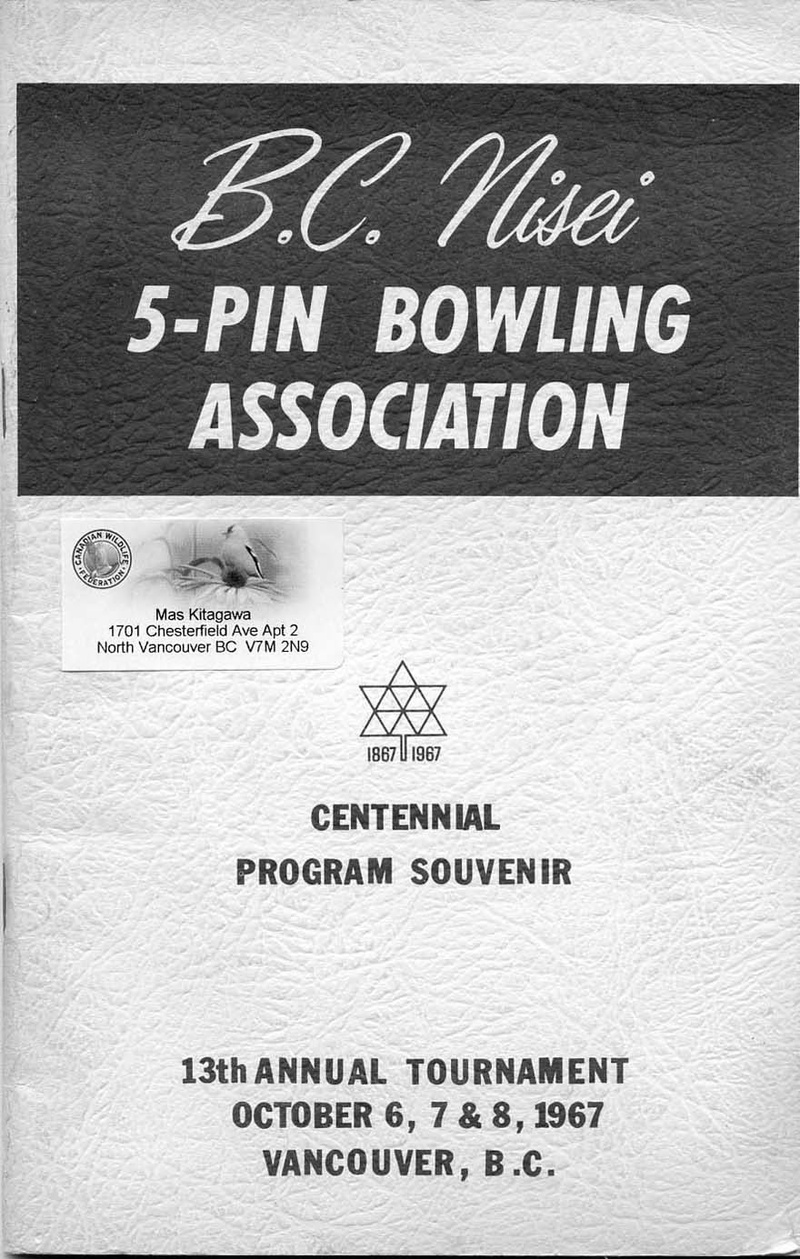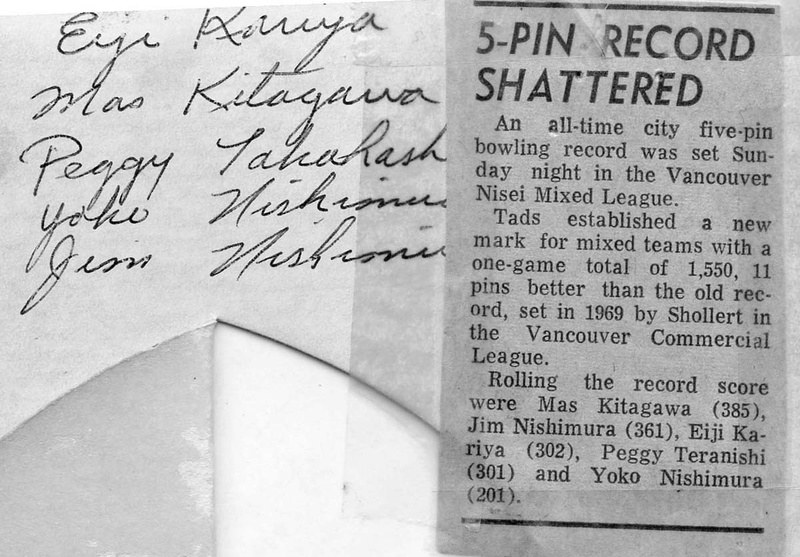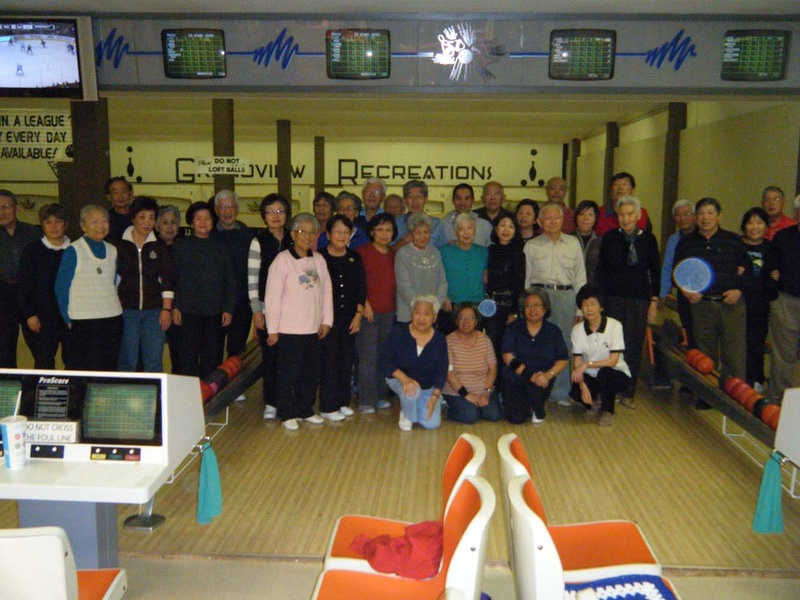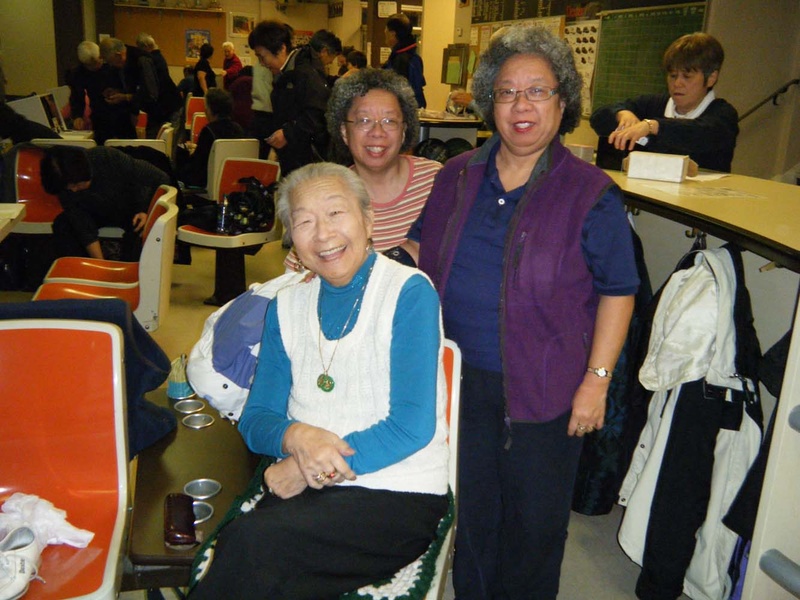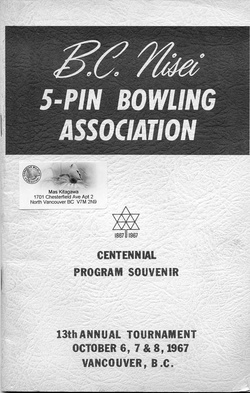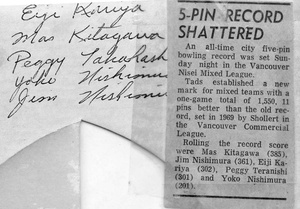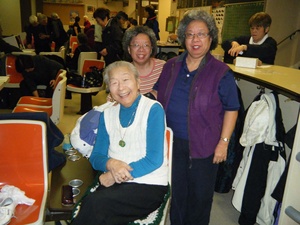In a survey conducted by the Canadian Broadcasting Corporation (CBC) in 2007, 5-pin bowling ranked #4 on a list of Canada’s 50 greatest inventions. The game was invented in 1908 by Thomas F. Ryan of the Toronto Bowling Club in response to customers who complained that the 10-pin game was too strenuous. It was introduced to western Canada in the 1920s and from Winnipeg spread westward. In the 1950s the first Canadian championships were held and its popularity grew. There were youth organizations, high school championships, and international events. In 1975, there were an estimated 680,000 bowlers in 20,000 leagues across Canada. Over the next twenty years the numbers declined and in 1995, female bowlers (63%) outnumbered the males (37%). Nikkei involvement in 5-pin bowling mirrors this trend.
In the 1940s in Grand Forks
Rev. Eddie Yoshida’s first encounter with the game began as a pin-boy during the later part of the internment years in Grand Forks. He writes from Toronto:
The first 5-pin bowling game was introduced to our famous Doukhobor town of Grand Forks, B.C. in 1947. Its owner was a second generation Doukhobor by the name of Sam. The novelty of the sport drew in the local police, government employees, small business owners, and other singles with extra money to enjoy the sport.
The Alley had 12 lanes with one pin-boy to cover 2 lanes each. Since our war-time home was in that area of town called Ruckle Addition, I grabbed at the first opportunity to become a pin-boy at age 14. Dad had no problem with this evening job because I was getting income of my own. Pin-boys sat between the two lanes on a narrow platform and dodged the pins that might fly up against the opposite wall, while jumping down to straighten up the pins that may fall on the lane when the ball hurtles between them. More than a few pin-boys have been injured while on duty. Most of these pinsetters were my Doukhobor pals. Ladies were gentler than some men. Some of the latter would arrive with their companions and hurl the ball as if to kill the pin-boy. They were usually drunk or wanted to show off their muscles before their lady.
I was happy to put up with the abuse because the pay was good for a part-time job, much better than weeding grass in the fields at 12 cents an hour or chopping wood at 15 cents. And it gave me side benefits. For a discount cost pin-boys were allowed to make their own ham and lettuce sandwich, and they could slice the ham as thick as they wanted. Then when the lanes were not occupied, they could practice their skills free of charge. It was also an opportunity to meet many of the citizens and townspeople in their raw deportment.
Later, this acquired skill came in handy in Toronto when I sponsored our church’s Youth Bowling Night in the 1960s. I am the only member of our extended family that owns his own bowling shoes today. My grandchildren asked me, “How come Grandpa has his own bowling shoes when we have to rent ours” on our infrequent bowling jaunts during winter.
Nisei return to Vancouver in the ’50s and ’60s
As Japanese Canadians returned to the coast from internment camps and from exile in Japan in the 1950s and 1960s, they sought out other Nikkei. Church workers filled in this need by hosting dances, sponsoring clubs and sports teams. Jim Nishimura remembers that Nobby Fujisawa, insurance agent for Sun Life, was a great organizer. “It was good for his business too. He organized the Maria Stella Club at the Franciscan Sisters of Atonement on East Cordova. That’s where we got married. It had a softball team and we played against all the other Catholic churches. It was the first to really start organizing.” The other gathering places were the United Church (where the Buddhist Temple is presently located) and the Japanese Language School.
Kaz Nakamoto remembers the dances. “The guys would line up on one side of the hall and the gals on the other side and then we would head for the gals. The dances were a lot of fun. That’s where I met my wife; at the Chinese community centre.” Bowling, however, was the most popular activity for the Nisei in the late 1950s and into the 1970s and many met their future spouses there.
The first Japanese Canadian league, the Nisei Bowling League, was formed in 1957 at the Deluxe Lanes on Hastings and Homer Streets but moved to the Commodore Lanes a couple of years later. The Deluxe then became the home of the Young Adult Buddhist Association Bowling League (YABA). In 1965 a few ex-members of the YABA organized into the Fuji League at the Grandview Lanes.
Fishermen bowlers missed too many games because they had to go fishing in the middle of the bowling season and so their season did not correspond to those of the other leagues. They formed a league of their own in Vancouver and in Richmond, to accommodate the seasonal nature of fishing. The Fishermen’s Leagues bowled at the Commodore and at Shellmont in Richmond.
Richmond was also home to the Steveston YABA League which began at Seafair Lanes and later moved to Shellmont Lanes. This social league, organized in the early 1970s by Miffy Ogawa, was made up of 60 Nisei, hakujin (white person) spouses, and friends and lasted for 22 years.
A safe haven
For Eddie Yoshida, bowling provided him with all the benefits: pocket money, a great ham sandwich, an opportunity to meet people, and to hone his skills. For the young Nikkei returning to the coast, bowling on a Nisei league gave them a safe haven from the racial prejudices some were experiencing in the larger society.
Hakujin had a choice of sports and teams to join but similar opportunities were not available to Japanese Canadians. Mickey (Mitsuo) Hayashi (1915-2012) returned to Vancouver from Winnipeg in 1962 and in 1964 broke the colour barrier at the Vancouver Golf Club when he was accepted as a member. Jim Nishimura joined the boy scouts in Vancouver but “when we went to the Crystal Pool, I was told to get out. They wouldn’t let me in.” He adds: “We stuck together because of our friends. We were comfortable. We avoided discrimination by staying together. There was protection there. I also learned how to box.” When looking for an apartment in Vancouver, Mas Kitagawa was told on the phone that “it’s available” but when he arrived on the doorstep, the owner would say “it’s taken.” This was not an uncommon occurrence.
Nisei in Seattle took legal action against the American Bowling Congress’ policy of prohibiting membership by people of colour and in 1950 the ban was lifted. Whether a similar official ban existed in BC is unknown but Toyo Takata in his book Nikkei Legacy writes that in Duncan on Vancouver Island, the only bowling alley had a sign “No Orientals.”
In a society less accepting than the present day, being together with other Nikkei brought with it companionship and unconditional acceptance. Japanese words thrown into their conversations did not offend. Their common experience of the relocation need not be voiced but was understood. They could share a sense of identity and pride in their Japanese heritage without fear. It was also an opportunity to meet the opposite sex and in fact “many of them eventually met their spouses.” Some just felt a little shy about joining an all hakujin league and the Nisei leagues provided a safe refuge for both the Nisei and Kika-Nisei (returning from Japan) to socialize and have some friendly competition as they struggled to begin their new life.
Bowling on a league united not only the Nisei in the Lower Mainland but also connected them to the Nisei in the BC interior. Both Kaz Nakamoto and Jiro Kamiya recall the formation of the Nisei Bowling League Association made up of leagues from Kamloops, Kelowna, Vernon, and Vancouver. Every Thanksgiving weekend one of the centres would host a provincial tournament consisting of singles, doubles, and team events. Vancouver was the host city every other year. The annual tournament for the Vancouver leagues was held during the Easter weekend and the centres in the interior would also send a team or two.
“Mr. Bowling” and the elite Nikkei bowlers
Mitz Nozaki’s life-long love for bowling began in 1927 as a 13-year-old hand-setting the pins at the Abbot Bowling Lanes in Vancouver. His summer job became a full time one when his passion for the game made him quit school and go to work full time with Frank Panvini, the owner. When Frank opened the Commodore Lanes and Billiards on Granville Street in 1930, Mitz moved there with him as a cashier. Celebrities bowled at the Commodore including Roy Rogers, who arrived on his horse after his show at the Pantages Theatre; Clark Gable; Jack Benny; and Buster Crabb. In 1942 Mitz was relocated to Blind Bay on the south shore of the main arm of Shuswap Lake, 22 km north of Salmon Arm and when restrictions were lifted in 1949, returned to the Commodore. In 1962 when Frank passed away, Mitz became its owner.
From the 1950s onward until his passing in June, 2004, Mitz was the biggest influence on 5-pin bowling in Vancouver and was affectionately called “Mr. Bowling”. For twenty-five years from 1958 to 1983, the Commodore hosted the All Star League, a 3-player, 4-game total scratch pinfall league, which became known as the league to play in during its time. Vancouver’s strongest and most competitive 5-pin bowlers, who posted some of the highest scores, bowled at the Commodore. Among them are three Nikkei: Koichi Kitagawa with a city record high average of 284.4 (1968/69), Frank Nozaki with a high four of 1,415 (1970/71), Paul Kitamura with a high single of 418 (1977/78) and a high four of 1,362 (1982/83) [www.willowbrooklanes.ca/bchistory/comm.html]. In 1969 Koichi Kitagawa was named the “Master Bowler of the Year” (The Province, March 1969).
The Commodore also hosted the Senior City Men’s League, Vancouver’s premier men’s league. In March 1973, the Nisei team established a league record “when they rolled a 4,393 series to come within 68 pins of breaking their own all time BC 5-pin record of 4,460 set in 1968.” The bowlers were: Paul Kitamura with a three game total of 1,014, Mas Kitagawa with 900, Fred Tsuji with 640, Jim Akune with 803, and Koichi Kitagawa with a “whopping” 1,036 (The Province, March 16, 1973).
The Fuji League to commemorate a half century
The Fuji League will celebrate 50 years of bowling in 2015. Its “home” has always been the Grandview Lanes on Commercial Street but due to lack of parking, recently moved to Orchard Lanes in Burnaby. The League started in 1965 with 8 lanes and grew to more than 16. In the 2010/11 season, there were 47 bowlers in two divisions: Class A consisted of 13 men and 14 women, and Class B, 9 men and 11 women.
Bowling with the Fuji League is a family affair. Jean Wakahara returned to Vancouver in 1958 from Japan and she and her husband joined YABA for some fun. When it folded in the early 1980s they joined Fuji. When her husband passed away, their daughter Linda and son Jeff joined the Fuji League also. Eventually Jean took over the finances and has served as treasurer for over ten years. Many of the present bowlers in the Fuji league are similarly related by blood, through marriage, or friendship.
Food is an important part of the social scene. Bowlers have their dinner before the games but many bring baked goods, manju, and other goodies which they display on the counters for everyone to share during the night. After the game some continue the feasting and socializing at a Chinese restaurant or some fast food outlet.
The Fuji League bowlers’ deliveries and strategies vary but the atmosphere is supportive and encouraging. Some start their throw right at the foul line while others as far back as possible. Some throws have hooks as they near the pins while others are happy if the ball just stays out of the gutter. Some bring their own personalized balls while others search for the least pock-marked of the balls provided by the Lane. Bowlers cheer and high five each other for the strikes, spares, and the occasional turkeys and give commiserating groans for the bedposts, missed pins, and opportunities. For those who ask, Ed Nakamoto, “the coach” is there to observe and offer advice. Ed bowls in another league and has a perfect 450 game to his credit!
Then there are the side pots…for the better bowlers. Each strike and spare adds a card to a poker hand. The best hand at the end of each of the three games wins a pot. There’s another three pots—for the highest score above average at the end of each game. Not to leave out the lesser bowlers, there are raffles and 50/50 draws. The 50/50 is divided into one-half for the league and the other half shared among several bowlers in lots of $10 prizes. Yes, “gambling” goes hand-in-hand with bowling.
Everyone’s a winner in the Fuji League. At the end of each evening, the president tallies the scores and adjusts the standings accordingly. In April, when a banquet is held at a Chinese restaurant, pins for bowlers who reached 300 are presented. No trophies are awarded but prizes in cash are distributed: the highest single, double, and the teams. The difference between the team that finished #1 at the top and #12 at the bottom is but a few dollars.
Recreational bowling is one sport where age, gender, size, skill, or eyesight does not matter. Anyone who wants some physical exercise, camaraderie, and a few laughs should give it a try. The Fuji League meets on Friday evenings at Orchard Lanes in Burnaby. The two seniors’ leagues remain at Grandview Lanes: Kaede meets on Monday afternoons and the Asahi on Sunday mornings.
A celebration is in the planning for the 50th anniversary of the Fuji League and all past and present bowlers and friends are invited to attend. For information, please contact Sam Kobayashi by phone 778-899-9805 or by email: samk8581@gmail.com or Kaz Nakamoto at kaznakamoto@shaw.ca or Jean Wakahara at chiko7@shaw.ca.
“Thank you” to all the bowlers who shared their recollections and photos for the article.
*This article was originally published in Nikkei Images, a publication of Nikkei National Museum & Cultural Centre Vol. 18, No. 2 Summer, 2013) and has been revised for publication on Discover Nikkei.
© 2013 Nikkei National Museum & Cultural Centre



